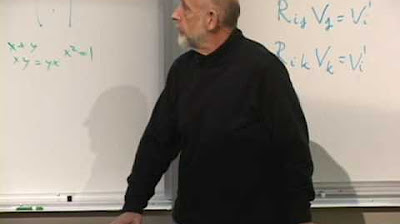Group theory, abstraction, and the 196,883-dimensional monster
TLDRThis video explores the concept of symmetry in mathematics through group theory, focusing on the 'monster' group, a massive finite simple group with about 8x10^53 elements. It discusses the importance of symmetry in understanding mathematical structures and the surprising connections between seemingly unrelated mathematical fields, such as the monstrous moonshine conjecture linking the monster group to modular functions.
Takeaways
- 🌌 The video discusses the concept of favorite numbers over one million, with the presenter choosing a number roughly 8x10^53, which is comparable to the number of atoms in Jupiter.
- 🔍 The number is highlighted for its peculiarity and fundamental nature, suggesting that it would be recognized as significant even by an alien civilization or an AI with no connection to human culture.
- 🤔 The explanation delves into group theory, which is about codifying symmetry. It explains how symmetries can be reflected in actions like reflections or rotations that leave an object unchanged.
- 🔄 Groups are collections of actions that preserve a certain structure, and they can be as simple as a single line of symmetry or as complex as the symmetries of a snowflake, denoted by names like D6 and C2.
- 🧩 The video emphasizes the fundamental nature of groups in mathematics, noting that they are as universal as the concept of symmetry itself.
- 🔢 The size of a group reflects the complexity of the symmetries it describes, with larger groups indicating a looser sense of structure preserved by the actions.
- 🔍 The video connects group theory to the solutions of polynomial equations, explaining how the structure of permutation groups can reveal the impossibility of certain formulas, like one for a quintic equation.
- 🌐 Noether's theorem is mentioned, highlighting the connection between symmetries (groups) and conservation laws in physics, showing the broad relevance of group theory.
- 🐉 The 'monster' is introduced as a large, complex group that acts in a high-dimensional space (196,883 dimensions), emphasizing its size and the mystery surrounding why such groups exist.
- 🌕 The concept of 'sporadic groups' is introduced, including the monster group and other groups that do not fit into the known patterns, adding to the complexity and intrigue of group theory.
- 🌕 The video concludes by reflecting on the fundamental but not necessarily simple nature of the universe, as exemplified by the monster group and its role in mathematics and physics.
Q & A
What is the significance of the number 8x10 to the 53 in the script?
-The number 8x10 to the 53 is significant because it represents the size of the 'monster' in group theory, which is a very peculiar number that reflects something fundamental and would be recognized as such by an alien civilization or a super-intelligent AI.
What is group theory and why is it important?
-Group theory is a field of mathematics that codifies the idea of symmetry. It is important because it provides a fundamental structure for understanding symmetries in various mathematical and physical contexts, and it has applications in solving polynomial equations and understanding conservation laws in physics.
What is the connection between symmetry and the concept of a group?
-A group is a collection of actions that leave an object looking the same. The concept of a group in mathematics is directly connected to symmetry because it captures all the ways an object can be symmetric, such as rotations, reflections, and permutations that preserve the structure of the object.
What is the role of the 'do-nothing' action in a group?
-The 'do-nothing' action, or the identity element, is considered part of every group. It represents the action that leaves the object unchanged and is crucial for the group operation to satisfy the requirement of having an identity.
Can you explain the concept of isomorphism in group theory?
-Isomorphism in group theory refers to a one-to-one correspondence between the elements of two groups that preserves the group operation. It means that the two groups have the same structure and behave identically in terms of their multiplication tables, even if they act on different sets of objects.
What is the significance of simple groups in the classification of all finite groups?
-Simple groups are the 'atoms' of group theory; they cannot be broken down into smaller groups. The classification of all finite groups involves identifying all simple groups and then understanding how they can be combined to form larger groups, similar to how prime numbers are combined in prime factorization.
What are the 18 infinite families and 26 sporadic groups mentioned in the script?
-The 18 infinite families and 26 sporadic groups are the complete classification of all finite simple groups. Infinite families are groups that can be described by a parameter that can take on infinitely many values, while sporadic groups are simple groups that do not fit into any of these infinite families.
What is the 'monster' group and why is it called so?
-The 'monster' group is the largest of the sporadic simple groups, with a size of approximately 8x10 to the 53. It is called the 'monster' due to its enormous size and the complexity of its structure, which is unlike any other group in mathematics.
What is the connection between the monster group and the concept of 'moonshine'?
-The term 'moonshine' was initially used to describe the surprising numerical coincidences between the monster group and modular functions in number theory. The 'monstrous moonshine conjecture' later formalized this connection, which was proved by Richard Borcherds, showing a deep link between these seemingly unrelated areas of mathematics.
Why is the monster group relevant to physics, specifically string theory?
-The monster group is relevant to physics, particularly string theory, because of its fundamental nature arising from symmetry. Symmetries are crucial in understanding the laws of physics, and the monster group, being a manifestation of symmetry, has been found to have implications in the mathematical structures underlying string theory.
What is the dimension of the space in which the monster group acts?
-The monster group acts in a space of 196,883 dimensions. This high-dimensional space is where the group's elements can be represented, although it is not visualizable in the same way as lower-dimensional symmetries.
Outlines
🌌 Introduction to Symmetry and Group Theory
The video introduces a collaborative project where mathematicians create videos about their favorite numbers over one million. The presenter chooses a number, 8x10^53, which is roughly the number of atoms in Jupiter. This number is significant because it is believed to be universally recognized as peculiar, even by alien civilizations or AI. The concept of symmetry is explored through group theory, which is the study of symmetry in mathematical structures. The video explains that a group is a collection of actions that preserve a certain structure, such as rotations or reflections. Examples include the symmetries of a snowflake (D6) and the simple group of symmetries of a face (C2). The video also discusses how the size of a group reflects the structure it preserves, with permutation groups like S-sub-n playing a crucial role in group theory.
🔍 Deep Dive into Group Actions and Their Abstractions
This paragraph delves deeper into the concept of groups, emphasizing that they are abstract entities that describe how elements combine, rather than specific actions on objects. The video uses the analogy of numbers and their operations to explain how groups are defined by their multiplication tables. It also highlights the importance of isomorphisms, which are one-to-one mappings that preserve the structure of groups, allowing for the comparison and understanding of seemingly unrelated mathematical structures. The video further explains that groups are fundamental to mathematics and have applications in various fields, including physics, where symmetries and conservation laws are connected through Noether's theorem.
🔬 Exploring the Structure of Finite Groups
The video discusses the classification of finite groups, which is akin to finding a periodic table for group theory. It explains that finite groups can be broken down into smaller groups, and the simplest of these, which cannot be further decomposed, are called simple groups. The task of categorizing all finite groups involves identifying all simple groups and understanding how they can be combined. The video mentions that mathematicians have successfully identified all finite simple groups, a monumental achievement that took decades and involved thousands of pages of complex mathematics. It also introduces the concept of sporadic groups, which are simple groups that do not fit into any infinite family, and the largest of these is the monster group.
👻 The Enigma of Sporadic Groups and the Monster
This paragraph focuses on the sporadic groups, which are a set of simple groups that do not fit into the patterns of infinite families. The largest of these, the monster group, is highlighted for its immense size (8x10^53) and its mysterious nature. The video explains that the monster group acts on a structure in 196,883 dimensions, which is beyond the scope of visual representation in lower dimensions. The video also touches on the concept of 'moonshine', a term coined by John Conway to describe unexpected numerical coincidences related to the monster group, which were later proven to be true in the monstrous moonshine conjecture. The connection between the monster group and string theory in physics is also briefly mentioned, emphasizing the group's relevance beyond pure mathematics.
🌟 The Monster Group and Its Unexpected Connections
The final paragraph discusses the unexpected connections of the monster group, particularly its relation to modular forms and elliptic functions, which was initially dismissed as a coincidence but later proven to be a deep mathematical truth. The video mentions the proof of the monstrous moonshine conjecture by Richard Borcherds, which earned him the Fields Medal. It also notes the connection between the monster group and string theory, suggesting that the group's symmetries are relevant to fundamental physical laws. The video concludes by reflecting on the complexity and non-intuitive nature of fundamental mathematical objects, emphasizing that the universe's underlying structures are not necessarily simple or clean, but are determined by logical necessity.
Mindmap
Keywords
💡Group Theory
💡Symmetry
💡Permutation Groups
💡Simple Groups
💡Sporadic Groups
💡Monster Group
💡Isomorphism
💡Noether's Theorem
💡Modular Forms and Elliptic Functions
💡String Theory
💡Polynomial Equations
Highlights
YouTube math community members are making videos about their favorite numbers over 1 million.
The speaker's choice is 8x10^53, roughly the number of atoms in Jupiter.
The number is peculiar and fundamental, reflecting something universal in mathematics.
Group theory is introduced as a field about codifying the idea of symmetry.
A group is a collection of actions that preserve a certain structure.
The group of symmetries of a snowflake is named D6 and includes 12 distinct actions.
Permutation groups, like S-sub-n, play a crucial role in group theory and encompass all other groups.
Group theory has applications in understanding solutions to polynomial equations.
The impossibility of a quintic formula is related to the structure of the permutation group S5.
Noether's theorem connects conservation laws in physics to symmetries and groups.
Groups are fundamental and universal, abstracted from the idea of symmetry actions.
A group is defined by a set of elements and a binary operation satisfying four axioms.
Isomorphism is a key concept in group theory, showing a one-to-one mapping that preserves composition.
The task of categorizing all finite groups involves finding all simple groups and ways to combine them.
All finite simple groups have been found, a monumental achievement in math history.
There are 18 infinite families and 26 sporadic groups, including the monster group.
The monster group is the largest sporadic group, with a size of 8x10^53.
The monster group acts in 196,883 dimensions, making it complex and mysterious.
The monstrous moonshine conjecture connects the monster group to modular forms and elliptic functions.
The monster group's relevance to string theory shows its importance in physics.
The monster group serves as a reminder that fundamental objects in math are not necessarily simple.
Transcripts
Browse More Related Video

Monster Group (John Conway) - Numberphile

Group Definition (expanded) - Abstract Algebra

Lecture 3: Birthday Problem, Properties of Probability | Statistics 110

Lecture 3 | New Revolutions in Particle Physics: Standard Model

Application: Spin structures - lec 27 - Frederic Schuller

Is Symmetry Fundamental to Reality? Gauge Theory has an Answer
5.0 / 5 (0 votes)
Thanks for rating: